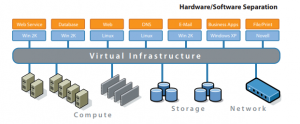
Virtualization is technology that lets you create useful IT services using resources that are traditionally bound to hardware. It allows you to use a physical machine’s full capacity by distributing its capabilities among many users or environments.
In more practical terms, imagine you have 3 physical servers with individual dedicated purposes. One is a mail server, another is a web server, and the last one runs internal legacy applications. Each server is being used at about 30% capacity—just a fraction of their running potential. But since the legacy apps remain important to your internal operations, you have to keep them and the third server that hosts them, right?
Traditionally, yes. It was often easier and more reliable to run individual tasks on individual servers: 1 server, 1 operating system, 1 task. It wasn’t easy to give 1 server multiple brains. But with virtualization, you can split the mail server into 2 unique ones that can handle independent tasks so the legacy apps can be migrated. It’s the same hardware, you’re just using more of it more efficiently.

